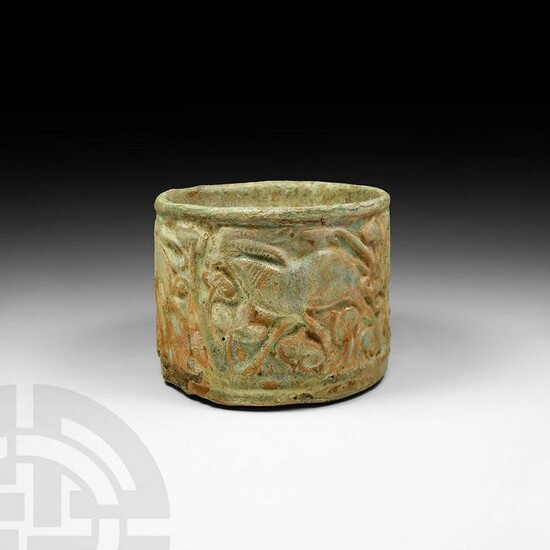Romano-Egyptian Pyxis with Animals
Roman Period, 30 BC-323 AD. A cylindrical mould-blown opaque glass or glazed composition pyxis with small everted cut rim, decorated in low relief with images of animals within foliage including a dromedary camel, an antelope, a swan and a lioness; under each animal a bunch of flowers, including a lotus flower of the Nilotic landscape; flat ribbed base. Cf. Grossmann, R.A., Ancient Glass, a guide to the Yale collection, Yale, 2002, figs.13 and 32, for a pyxis and a cup executed in same technique; for a similar pyxis with a lid, see the mould-glass specimen in the Los Angeles County Museum of Art; the specimens of pyxides in the Carnegian Museum of Natural History, Pittsburgh, nos.29493/1, in Bergman, M.S. and Oliver, A. jr., Ancient Glass in the Carnegian Museum of Natural History, Pittsburgh, Pittsburgh, 1980, figs.52, pp.61, 65; see also similar pyxis in Harden, D.B., Glass of the Caesars, Milano, 1987, no.81. 471 grams, 11.7cm (4 1/2"). From an important London W1, gallery; said to be previously in the collection of Ismail Pasha (ruled 1863-1879); accompanied by an archaeological report by Dr Raffaele D’Amato; this lot has been checked against the Interpol Database of stolen works of art and is accompanied by AIAD certificate number no.10633-174284. Mould-blown glass, which appeared in the early 1st century AD, was essentially the product of blowing and casting techniques. The pyxis is related to a series of cosmetic vessels, usually decorated with plant and geometric motifs, which in our specimen is enriched by the presence of animals taken from the Nilotic fauna.
Condition Report: Fine condition.
View it on
Estimate
Time, Location
Auction House
Roman Period, 30 BC-323 AD. A cylindrical mould-blown opaque glass or glazed composition pyxis with small everted cut rim, decorated in low relief with images of animals within foliage including a dromedary camel, an antelope, a swan and a lioness; under each animal a bunch of flowers, including a lotus flower of the Nilotic landscape; flat ribbed base. Cf. Grossmann, R.A., Ancient Glass, a guide to the Yale collection, Yale, 2002, figs.13 and 32, for a pyxis and a cup executed in same technique; for a similar pyxis with a lid, see the mould-glass specimen in the Los Angeles County Museum of Art; the specimens of pyxides in the Carnegian Museum of Natural History, Pittsburgh, nos.29493/1, in Bergman, M.S. and Oliver, A. jr., Ancient Glass in the Carnegian Museum of Natural History, Pittsburgh, Pittsburgh, 1980, figs.52, pp.61, 65; see also similar pyxis in Harden, D.B., Glass of the Caesars, Milano, 1987, no.81. 471 grams, 11.7cm (4 1/2"). From an important London W1, gallery; said to be previously in the collection of Ismail Pasha (ruled 1863-1879); accompanied by an archaeological report by Dr Raffaele D’Amato; this lot has been checked against the Interpol Database of stolen works of art and is accompanied by AIAD certificate number no.10633-174284. Mould-blown glass, which appeared in the early 1st century AD, was essentially the product of blowing and casting techniques. The pyxis is related to a series of cosmetic vessels, usually decorated with plant and geometric motifs, which in our specimen is enriched by the presence of animals taken from the Nilotic fauna.
Condition Report: Fine condition.



